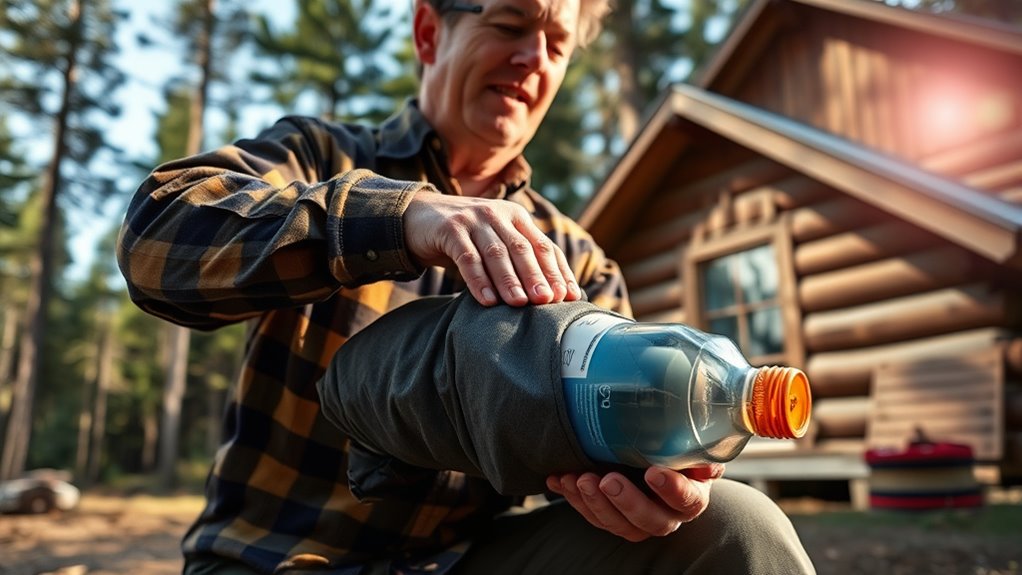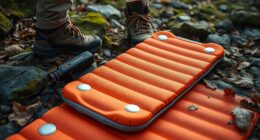In remote homesteads, having basic first aid and CPR skills is crucial since help might be hours away. Focus on mastering essential techniques like controlling bleeding, treating burns, and performing CPR confidently. Keep your emergency kit stocked and organized, and learn signaling methods to attract attention when needed. Regular practice will boost your confidence and response time. If you’re enthusiastic to become better prepared, there’s more important knowledge to discover here.
Key Takeaways
- Learn essential CPR techniques, including chest compressions and rescue breaths, tailored for limited medical resources.
- Prepare a comprehensive emergency kit with first aid supplies and regularly check for expiration dates.
- Practice basic first aid skills such as wound dressing, bleeding control, and splinting to respond effectively.
- Develop signal signaling skills using mirrors, whistles, or fires to attract rescue attention when communication is limited.
- Stay informed on safety protocols and conduct regular drills to boost confidence and preparedness in remote settings.

Living on a remote homestead means you’re often miles from immediate medical help, making it essential to know basic first aid and CPR skills. When accidents happen, quick, effective action can mean the difference between a full recovery and a serious complication. Preparing yourself involves more than just knowing how to perform CPR; it also includes assembling comprehensive emergency kits and understanding signal signaling techniques to attract help when needed.
An emergency kit should be a cornerstone of your homestead preparedness. It needs to contain essentials like bandages, antiseptics, pain relievers, and tools such as scissors and tweezers. Including items like a thermometer, gloves, and a flashlight with extra batteries is also vital. For more advanced needs, consider adding a tourniquet, burn ointments, and a first aid manual. Keep your emergency kit in an accessible location, and regularly check expiration dates on supplies. Having a well-stocked kit ensures you can handle cuts, sprains, insect bites, or more serious injuries until professional help arrives or you can reach medical facilities. Proper storage and organization of your supplies can also save valuable time during emergencies.
Signal signaling becomes your lifeline when you’re far from help. Since cell service might be unreliable or unavailable, learning how to effectively use signal signaling methods is crucial. Flares, whistles, mirror signaling, or even creating large, visible signals on open ground can draw attention from rescue teams or passing aircraft. A whistle, in particular, is a simple yet powerful tool—blowing it repeatedly can alert nearby search parties or neighbors. Mirrors are effective for daytime signaling, especially if you aim sunlight at a distant observer. At night, a flashlight or even a fire can serve as a signal to attract attention. Remember to create signals in open, unobstructed areas, and familiarize yourself with techniques like the international distress signals to maximize your chances of being rescued. Developing emergency communication skills can significantly improve your chances of attracting help in critical situations. Additionally, knowing basic first aid and CPR techniques is essential because immediate care can stabilize injuries until professional help arrives.
In a remote setting, your ability to perform first aid and CPR, combined with effective signal signaling, defines your resilience. Practicing these skills regularly, maintaining your emergency kits, and knowing how to attract help can make all the difference in critical moments. The more prepared you are, the better equipped you’ll be to handle emergencies independently, ensuring safety for yourself and anyone else on your homestead. Ultimately, your proactive approach to emergency preparedness can turn a potentially tragic situation into a manageable one, giving you peace of mind amidst the isolation. Building first aid proficiency through regular practice enhances your confidence and effectiveness during emergencies. Staying informed about safety protocols relevant to your environment further strengthens your readiness and response capabilities.
Frequently Asked Questions
How Often Should I Update My First Aid and CPR Training?
You should update your first aid and CPR training every two years to keep your skills sharp. Regular training refreshers guarantee you’re prepared for emergencies, and certification updates confirm you’re current with the latest protocols. Don’t wait until an emergency happens—staying consistent with your training refreshers helps you respond confidently and effectively, especially in remote homestead settings where quick help might be scarce.
What Emergency Supplies Are Essential for Remote Homesteads?
Imagine your homestead as a fortress, ready to face any storm. Your emergency kit is your shield, packed with essential survival gear like bandages, antiseptics, a flashlight, and a multi-tool. These supplies are crucial for emergencies, ensuring you’re prepared to protect and heal. Keep your emergency kit stocked and accessible, turning your homestead into a safe haven where you can respond swiftly and confidently when disaster strikes.
Can CPR Be Performed on Animals in Emergencies?
In an emergency, you might wonder if CPR can be performed on animals. Yes, veterinary CPR exists for animal rescue, and you can learn how to do it if needed. It involves chest compressions and rescue breaths tailored for different animals. While not a substitute for professional veterinary care, knowing animal rescue techniques can help you save a pet’s life until help arrives.
How Do I Handle a Broken Bone Without Immediate Medical Help?
Dealing with a broken bone demands decisive, diligent action. First, control bleeding by applying gentle pressure with a clean cloth. Then, stabilize the injury by carefully applying a splint—use sturdy sticks or rolled-up clothing—keeping the joint immobilized. Elevate the limb if possible, and avoid unnecessary movement. Remember, your quick, calm care minimizes pain, prevents further damage, and prepares you for eventual professional help.
What Are Common First Aid Mistakes to Avoid in Remote Settings?
In remote settings, avoid common first aid mistakes like improper wound management, which can cause infection, and incorrect CPR technique, reducing survival chances. You might be tempted to move someone with a broken bone too much or delay cleaning a wound. Stay calm, keep your actions deliberate, and follow proper procedures. Remember, rushing or guessing can worsen the situation. Focus on stabilizing injuries and seeking professional help as soon as possible.
Conclusion
Mastering basic first aid and CPR is like having a trusty lantern in the dark—guiding you safely through emergencies. When you’re miles from help, your skills become the lifeline, the steady heartbeat of your homestead. With knowledge in your toolkit, you hold the power to turn chaos into calm, transforming uncertainty into confidence. Remember, you’re the hero of your story—ready to face any challenge that comes your way with courage and care.










